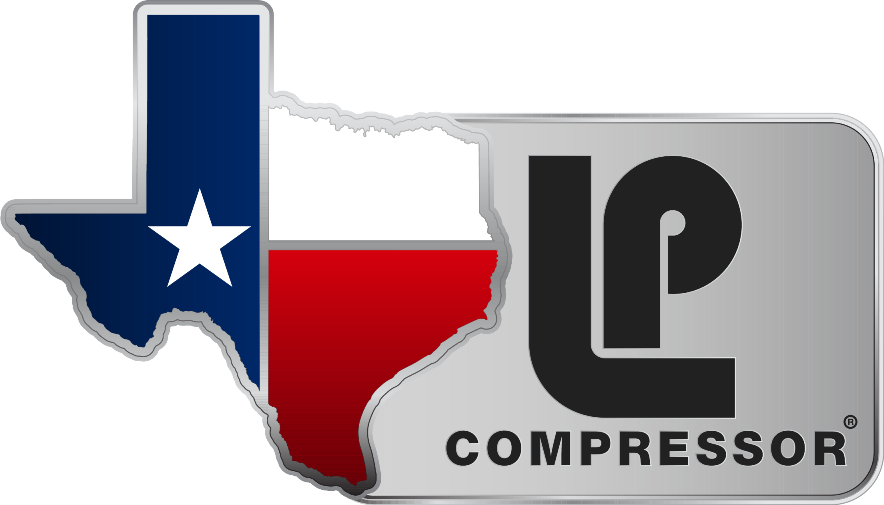| Troubleshooting | FAQ | Manuals | Wiring Diagrams | Air Tool Guide |
|---|
Warranty
Download
Trouble-Shooting
Open Troubleshooting PDF
| Problem: | Possible Causes: | Solutions: |
|---|---|---|
| Breaker Trips |
|
|
| Compressor Stalls |
|
|
| Low Discharge Pressure |
|
|
| Compressor Pump Knocking |
|
|
| Excessive Oil Discharge in Air |
|
|
| Compressor Overheating |
|
|
| Excessive Belt Wear |
|
|
| Compressor Motor Hums or Won't Start |
|
|
| Compressor Has Power, Will Not Start |
|
|
FAQ
Open FAQ as PDF
| Maintenence | |
|---|---|
| How often should I change my LP Compressor's oil? | LP Compressor's come standard with "break-in" oil designed for the first 50 hours. Accurate oil change intervals should be determined by a fluid sampling report and directed by the analysis. A rough guideline for most LP Compressors is to change the oil every 3 months. |
| When should I replace the Air Intake Filter? | The Air Intake Filter should be cleaned on a semi-daily basis. When the filter accumulates debris that does not come out during cleaning, or develops tears or holes, the filter should be replaced. |
| What is the difference between stop-start and constant run? |
Simply put, a start-stop air compressor has a pressure switch that turns the machine on and off. Most samll electric and gasoline air compressors are start-stop. A constant run compressor means the motor continuously runs and continuously turns the pump. Industrial shops who need constant air, on a daily basis, will need to purchase one of our constant run compressors. |
| Voltage | |
| What voltage should I run my LP Compressor on? | It depends on the size of the compressor and what your compressor has been designed for. Most larger models run on Single Phase 208-230 or 3 Phase 208-230/460. |
| Will my LP Compressor run on a generator? | It is not recommended to use a generator to power any compressor. Generators have fluctuations in power and compressors require constant voltage to be able to run. |
| Water | |
| What happens if water is left in my LP Compressor tank? | Compressor tanks are made of steel and rust will start to occur if water is left in the tank. It is best to drain your tank with the drain valve daily to eliminate this problem. |
| Hoses | |
| What size hoses should I use with my LP Compressor? | This will depend on the type of LP Compressor you have. The two most commonly used sizes are 1/4" and 3/4" hose. Check your compressor's maual or discharge port. |
| What is the maximum length hose I should use with my LP Compressor? | This will depend on the size of your compressor and the CFM required. Generally, for a small portable unit, 150' is the maximum. For an Industrial Series compressor that length can be much greater. |
| Other | |
| How much air will I need to power my air compressor tools? | Please see the LP Air Tool CFM Guide for a list of tools and their respective CFM requirements. |
| How often should I service my LP Compressor? | This depends on how often you run your compressor. If you are only running it occassionally then annual service should be fine. If you use your compressor daily then quarterly maintenance is suggested. |
| My compressor stores air at a high pressure, yet my tools require a low pressure, what should I do? | This is a common problem, but luckily there is an easy fix. To provide the required pressure to your tools, add a pressure regulator to your line. Pressure regulators can be set for any desired pressure, giving you the correct air pressure when the air reaches your tool. |
Manuals
| Industrial | Commercial | Portable Electric | Tank Mount | Single Stage Pumps | Two Stage Pumps |
|---|---|---|---|---|---|
|
V8071-205 |
V60215-755 V60218-V8060 |
Manual |
LPS5138 LPS6546 LPV5145 LPSS7538 LPSS7550 LPV6546 LPW6548 LPV8060 LPW8060 |
LP205 LP210 LP332 |
Wiring Diagrams
| Commercial | Industrial |
|---|---|
|
3 HP Single Phase 4-5 HP Single Phase |
Single Phase Three Phase Electrical Check (Express) Electrical Check (Extensive) |
AIR TOOL CFM GUIDE
Open CFM Guide as PDF
For continuous use, multiply "Average CFM x 4" to get a continuous CFM rating for the tool.
| Air Tool | Average CFM @ 90 PSI |
|---|---|
| Air Reciprocating Saw | 7 |
| Angle Disc Grinder (7") | 5-8 |
| Angle Polisher | 8 |
| Brad Nailer | 0.3 |
| Buffer | 13 |
| Chisel/Hammer | 3-11 |
| Cut-Off Tool | 4-10 |
| Drill | 3-6 |
| Dual Sander | 11-13 |
| Framing Nailer | 2.2 |
| Grease Gun | 4 |
| Hydraulic Riveter | 4 |
| Impact Wrench (3/8") | 2.5-3.5 |
| Impact Wrench (1/2") | 4-5 |
| Impact Wrench (1") | 10 |
| Mini Die Grinder | 4-6 |
| Needle Scaler | 8-16 |
| Nibbler | 4 |
| Orbital Sander | 6-9 |
| Paint Spray Gun | 7-9 |
| Ratchet (1/4") | 2.5-3.5 |
| Ratchet (3/8") | 4.5-5 |
| Rotational Sander | 8-13 |
| Sand Blast Cabinet | 9-15 |
| Shears | 8-16 |
| Speed Saw | 5 |

